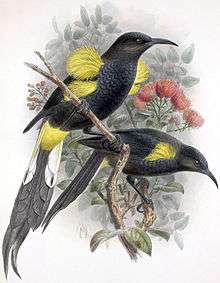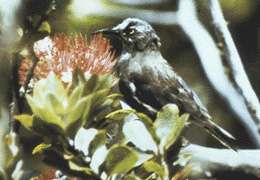Moho (genus)
| ʻŌʻō | |
|---|---|
 | |
| Kauaʻi ʻōʻō (Moho braccatus), the last surviving Mohoidae (extinct c. 1987) | |
| Scientific classification | |
| Kingdom: | Animalia |
| Phylum: | Chordata |
| Class: | Aves |
| Order: | Passeriformes |
| Suborder: | Passeri |
| Infraorder: | Passerida |
| Family: | † Mohoidae |
| Genus: | † Moho Lesson, 1830 |
| Species | |
|
see text. | |
Moho is a genus of extinct birds in the Hawaiian bird family, Mohoidae, that were endemic to the Hawaiian Islands. Members of the genus are known as ʻōʻō in the Hawaiian language. Their plumage was generally striking glossy black; some species had yellowish axillary tufts and other black outer feathers. Most of these species became extinct by habitat loss and by extensive hunting because their plumage were used for the creation of precious ʻaʻahu aliʻi (robes) and ʻahu ʻula (capes) for aliʻi (Hawaiian nobility).[1][2] The Kauaʻi ʻōʻō was the last species of this genus to become extinct, probably a victim of avian malaria.[3]
Until recently, the birds in this genus were thought to belong to the family Meliphagidae (honeyeaters) because they looked and acted so similar to members of that family, including many morphological details. A 2008 study argued, on the basis of a phylogenetic analysis of DNA from museum specimens, that the genera Moho and Chaetoptila do not belong to the Meliphagidae but instead belong to a group that includes the waxwings and the palmchat; they appear especially close to the silky-flycatchers. The authors proposed a family, Mohoidae, for these two extinct genera.[4]
The album O'o by jazz composer John Zorn, released in 2009, is named after these birds.
Taxonomy
The following species belong to this genus (in addition, subfossil remains of a species are known from Maui and known in literature as the Maui ʻōʻō, Moho sp.):
| Image | Common name | Latin name | Extinct since |
 | Oʻahu ʻōʻō | Moho apicalis | c. 1837 |
 | Bishop's ʻōʻō or Molokaʻi ʻōʻō | Moho bishopi | c. 1904 |
 | Hawaiʻi ʻōʻō | Moho nobilis | c. 1934 |
 | Kauaʻi ʻōʻō | Moho braccatus | c. 1987 |
References
- ↑ Flannery, Tim; Peter Schouten (2001). A Gap in Nature: Discovering the World's Extinct Animals. Atlantic Monthly Press. pp. 30, 110. ISBN 978-0-87113-797-5.
- ↑ Ratzel, Friedrich (1896). "The History of Mankind". London: MacMillan. Retrieved 15 August 2012.
- ↑ Fuller, Errol (2001). Extinct Birds. Cornell University Press. pp. 329–337. ISBN 978-0-8014-3954-4.
- ↑ Fleischer, Robert C.; James, Helen F.; Olson, Storrs L. (2008). "Convergent Evolution of Hawaiian and Australo-Pacific Honeyeaters from Distant Songbird Ancestors". Current Biology. 18 (24): 1927–31. doi:10.1016/j.cub.2008.10.051. PMID 19084408.
Bibliography
- Day, David (1981): The Doomsday Book of Animals
- Greenway, James C. (1967): Extinct and Vanishing Birds of the World
External links
- Short description of the Moho species (French)
- "Bishop's ʻŌʻō" (PDF). Hawaii’s Comprehensive Wildlife Conservation Strategy. State of Hawaiʻi. 2005-10-01.
- "Kauaʻi ʻŌʻō" (PDF). Hawaii’s Comprehensive Wildlife Conservation Strategy. State of Hawaiʻi. 2005-10-01.
- Naturalis - Hawaiʻi ʻŌʻō